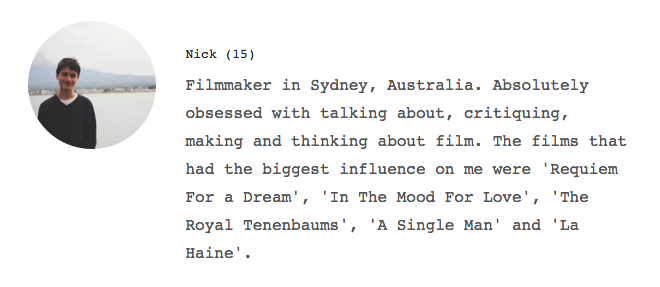What I finally realised after writing about low-key or lesser known arthouse films, is that a lot of them have really limited home-video release, or are only available overseas. In Australia, we don’t really have any arthouse or foreign film home-video distributors, and can only find decade-old, low- resolution DVDs, that do not do justice to the director’s intent. For those who really want to maximise the amount of films they could have access to, you could buy a region-free Blu-Ray player online, so that you can watch films from the Criterion Collection or other overseas releases. However, with streaming services increasingly becoming more competitive, Netflix is starting to up their game, and trying to cater to the most amount of film tastes as possible.
Netflix has a lot of fantastic films in their catalogue, and this variety of movies is only going to continue to grow. Some films that were previously accessed through poor DVD releases, can only be found in high-definition on Netflix. Now, I have a few friends and family members who are always asking for recommendations. I love recommending films to people, and am always eager to hear people’s reactions and thoughts on films – whether they’re positive or negative. So I had the idea that every now and then, I’d write an article on three films that I love that can be streamed. Rather than just scaling my favourite film list, I want to instead choose three very different films, and will try to include different genres, forms (both non-fiction and narrative) and countries of origin. Now that I’ve finished this rather long preface (don’t worry, none of the other articles in this series will have such a long introduction), I’ll get started on my picks.
–
Babel (2006) – dir. Alejandro González Iñárritu
From the director of Amores Perros, Birdman and The Revenant, comes the 2006 winner of the Cannes Best Director award and Golden Globe winner for Best Drama. Iñárritu is one of the best directors working in cinema today, continuously pushing boundaries and always blowing me away with every film that he releases. Describing the plot of Babel is a gruelling task, because on one hand, I don’t want to give anything away, and on the other, I could talk about this film for hours. To put it simply, this is a film that follows four groups of characters, four different languages, and four different countries; exploring the networks between people, and how despite language or physical barriers – we are all connected. Those four different countries are: America, Morocco, Mexico and Japan. The film stars Brad Pitt, Cate Blanchett, Gael García Bernal, Rinko Kikuchi and Adriana Barraza. Every single performance, even by the many first-time or child actors, is fantastic and heartbreaking – my favourite being from Kikuchi, who plays a troubled, deaf-mute Japanese schoolgirl in Tokyo. The score to this film by Oscar-winner Gustavo Santaolalla is tense, yet gorgeous. The music changes depending on the country that the scene is taking place, so finger- picked guitar for Morocco, lush, synthetic drones for Tokyo, and so on. This film also features one of the most beautiful pieces of Japanese music ever written – ‘Bibo no Aozora’ by one of my favourite composers, Ryuichi Sakamoto. This film hooked me from start to finish, and left me speechless. I actually offered to watch this film twice in one day, just so I could show my parents. I cannot recommend this film enough, and is the first film I thought about when I had the idea for this series. I would encourage you to not read into this film at all, or watch any of the trailers, since they give a fair bit away.
Jiro Dreams of Sushi (2011) – dir. David Gelb
A great documentary, and also a fascinating character study, Jiro Dreams of Sushi documents the career of the greatest sushi chef of all time – the 3 Michelin Star awarded Jiro Ono. The film focuses on how he runs his restaurant (Sukiyabashi Jiro) in Tokyo, the gruelling training process for employees, and the absolute focus and determination that he has, to sustain his prestigious title. It also follows his son, who works at the restaurant too. There is a section of the film dedicated to how the son must preserve his father’s legacy, with many people saying that to receive the same praise as his father, he would have to make sushi twice as good as him. This film is also infamously known and straight-up “food-porn”. There is a particular scene in the film, where Jiro makes every single piece of sushi on the menu. This is by far, one of the most mouth-watering sequences in any documentary, I have seen. The film is shot with a very shallow depth of field, and in many cases, slow-motion. This gives the film a very distinctive aesthetic, when paired with the very woody interior of the restaurant. This is a touching, riveting documentary, that I have revisited many times, and would encourage others to watch too.
Frances Ha (2013) – dir. Noah Baumbach
I remember the first time I watched this film on Netflix. I was looking for something short to watch and I had no idea what it was, other than it was made by Noah Baumbach (The Squid and The Whale, Greenberg), and was shot in black and white. It has since turned out to be one of my favourite comedy films, and also one of the films that makes me wanna go back to New York as soon as possible. The film follows Frances, played by the formidable Greta Gerwig. Frances is young woman, who isn’t really ready for adult life, and struggles with her responsibilities. The film follows Frances over an unknown period of time, as she moves between apartments and jobs. It also covers her relationship with her best friend, Sophie (Mickey Summer), who she met at school. While Sophie matures, and develops into a woman, Frances is almost like a child stuck in an older person’s body.
The way that Baumbach frames New York is comparable to Woody Allen’s Manhattan, in crisp black and white and with a shallow depth of field. In fact, the first time I watched it, I couldn’t get the Woody Allen similarities out of my head, mainly from the quirky dialogue and depiction of the New York lifestyle. Allen is not the only filmmaker that Baumbach commonly references in the film though. There is a heavy French influence on the film, from the soundtrack, which borrows themes from Georges Delerue, who composed music for many French films during the 50s and 60s, to actually recreating the David Bowie scene from Leos Carax’s ‘Mauvais Sang [Bad Blood]’. However, the main influence I saw on the film was from the work of nouvelle vague auteur, François Truffaut. The way that Baumbach shoots New York is incredibly reminiscent of the way that Truffaut framed Paris during his earlier career. Baumbach uses extremely limited camera movement, and stated that he only moved the camera, when Frances is moving forward in her life as well. It is a film that deals with adulthood, maturity and responsibility and is so easy to fall in love with. I could watch this movie in any mood, and I can’t recommend it enough.
–
So that’s it for my first entry in this Three Films You Have No Excuse Not to Watch series. I really do hope you check out at least one of these films, since they are literally at your fingertips, and you technically carry them around in your pocket or laptop case. I’ll return with another article in this series soon, but first, I’ll give you time to watch the films mentioned above (‘Babel’, ‘Jiro Dreams of Sushi’ and ‘Frances Ha’). These three films are all very different from each other, so whatever mood you may be in, at least one should be appropriate. I really hope you enjoy and feel free to leave a comment with your thoughts on any of the films.
The content and information is provided by FIR members and contributors, any reference in this site to any specific online content, product, provider or service, or the use of a corporate name is for information only, and does not constitute endorsement or recommendation by FIR.

